The naveAn arcade, covered with two rows of scenes in mosaic, divides the central nave from the side aisles. The nave is covered with an elaborate painted wooden ceiling. |
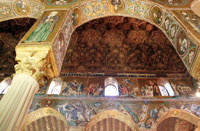 |
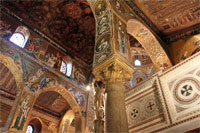 |
| |
|
The nave depicts scenes from Genesis; here are the creation of Adam; the departure from the Ark after the Flood; the building of the Tower of BabelIn the creation scene the artist uses a visible beam to indicate God's creative power--a visual clue used elsewhere; in the Flood scene, recently released animals are happily grazing while God's promise is illustrated as He stands below a rainbow. In the Babel scene the building techniques resemble those of medieval masons as they construct a medieval edifice. When God appears in these panels the inscription identifies him as "DS" (Deus).
|
 |
 |
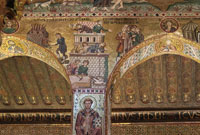 |
| |
|
The nave ceiling, probably constructed and painted by Egyptian artists, beginning of 12th century The ceiling above the nave is remarkable but not easily visible from below. This wooden roof is formed of twenty eight-pointed star-shaped panels interspersed by stalactites. These panels contain images of men and animals with backgrounds depicting nature or geometric motifs or Arabic inscriptions, common in Islamic art. This wide ceiling is separated from the wall mosaics by a band of decoratively painted muqarnas. The hundreds of facets were painted, not only with purely ornamental vegetal and zoomorphic designs but also with scenes of daily life and court life. Some depict scenes of entertainment with dancing girls and cup bearers, subjects common in Islamic court life. Portraits of Roger II (complete with crown, black hair, and pointed beard) also occur in some of the small paintings in the muqarnas ceiling. |
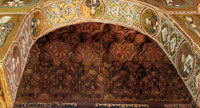 |
| |
|
 |
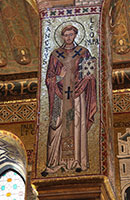 |
The piers above the columns, from which the arches spring, are also covered with mosaics, full sized saints of medallion portraits. |
| |
|
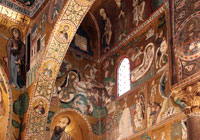 |
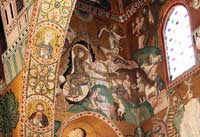 |
South TranseptThe short and narrow transept ends with apse painting of St. Paul and above him
are depicted scenes of the birth of Jesus: the annunciation to the shepherds, the visit of the Magi, the washing of the baby Jesus by the midwives (apocryphal). |
| |
|
Transept paintings, south wallThe short and narrow transept depicts other scenes from the life of Christ, her illustrated, the transfiguration and the entry into Jerusalem. There are no scenes of the death of Christ--or of Peter and Paul. Since this chapel served as a reception area for King Roger II as well as a place of worship, perhaps this triumphant king did not wish to have such scenes coloring his reign.
|
 |
 |
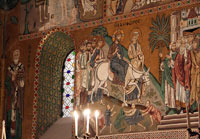 |
| |
|
The pulpit in the south aisle; the glorious inlaid floor
|
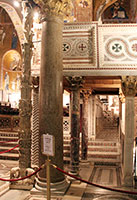 |
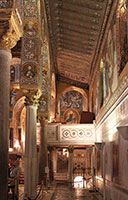 |
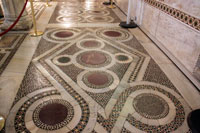 |

















